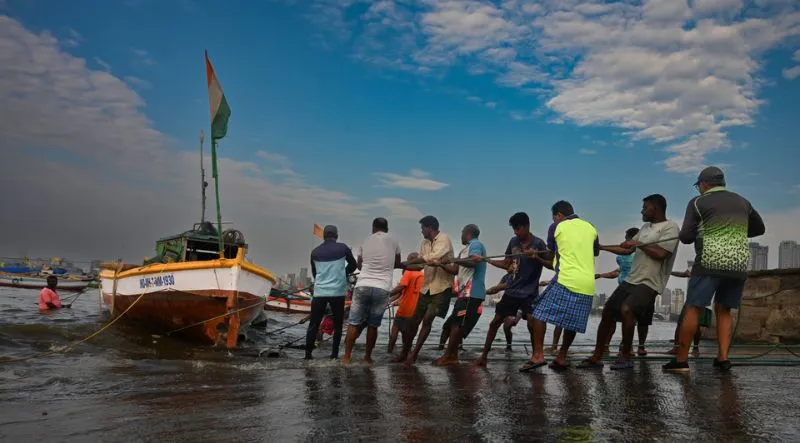The India Meteorological Department (IMD) has issued a severe rainfall alert for Goa and several regions in Maharashtra as a low-pressure system has begun to intensify over the Arabian Sea. This weather development comes at a critical juncture during the monsoon season, bringing not just much-needed precipitation but also the threat of flash floods, waterlogging, and travel disruptions. The alert is a warning for residents, authorities, and tourists to stay vigilant and prepare for potentially extreme weather conditions in the coming days.
What Is Causing the Severe Rainfall Alert?
According to the IMD, a cyclonic circulation over the east-central Arabian Sea has evolved into a low-pressure area, which is now moving in a north-northwestward direction. This meteorological phenomenon is drawing in a significant amount of moisture-laden winds from the southwest monsoon current, thereby enhancing rainfall activity across the Konkan coast. The states of Goa and Maharashtra are particularly vulnerable due to their coastal geography and the funneling effect of the Western Ghats, which can amplify rainfall intensity. As a result, the IMD has sounded a severe rainfall alert across these regions.
Heavy Showers Predicted Across Key Districts
The IMD forecast includes intense rainfall in major districts like Sindhudurg, Ratnagiri, Raigad, and Palghar in Maharashtra, as well as widespread downpours across Goa. The coastal belt is expected to bear the brunt of the rainfall, with some areas likely to experience more than 100 mm of rain in a single day. The severe rainfall alert is particularly crucial for low-lying and flood-prone regions, where even a few hours of heavy rain can lead to overflowing drains, damaged roads, and disrupted livelihoods.
IMD’s Forecast and Warning Criteria
IMD classifies rainfall alerts based on anticipated rainfall amounts and associated hazards. A severe rainfall alert generally indicates the possibility of extremely heavy rainfall — over 115.6 mm in 24 hours — that may lead to significant disruptions. In this case, the forecast suggests the low-pressure system could strengthen further, thereby increasing the intensity and duration of rainfall over the next 48 to 72 hours. Authorities have been asked to remain on high alert and activate disaster response teams as necessary.
Impact on Daily Life and Infrastructure
The severe rainfall alert is likely to impact various aspects of daily life, including transportation, schooling, and local economies. Train and flight services in affected areas might face delays or cancellations. Power outages due to damaged lines, waterlogging in city streets, and landslides in hilly areas are also probable. Public transport agencies have been advised to operate with caution, and local governments are expected to set up temporary shelters for affected populations if flooding worsens. In Goa, which sees a heavy influx of tourists during the monsoon, hospitality and tourism operators have been advised to take precautionary measures and avoid risky coastal excursions.
Advisory for Residents and Tourists
The IMD has urged residents in Goa and Maharashtra to take the severe rainfall alert seriously. Individuals living in low-lying areas should be prepared for possible evacuation. It’s advisable to stock up on essentials, avoid non-essential travel, and keep mobile phones charged in case of power failures. Tourists are being cautioned against venturing into rivers, beaches, or waterfalls, which can become dangerous due to rapid water level rises. The Coast Guard and local police have increased patrolling along beach zones to prevent accidents.
School Closures and Government Measures
In response to the severe rainfall alert, some districts in Maharashtra and Goa have announced the closure of schools and colleges for the next couple of days. Government agencies, including the National Disaster Response Force (NDRF) and State Disaster Management Authorities (SDMA), are coordinating closely to monitor the situation and provide relief if necessary. Mobile warning messages are also being disseminated via SMS to keep the public informed about weather developments and emergency protocols.
What to Expect in the Coming Days
Meteorological models suggest that the low-pressure system may continue to deepen and interact with the monsoon trough, which could prolong the spell of heavy rainfall. The IMD has not ruled out the possibility of the system turning into a depression. If this occurs, the severe rainfall alert may be extended and expanded to include more districts across the western coast. Continuous updates are being issued through IMD’s official channels, including their website, mobile app, and social media platforms.
Preparedness Is the Key
With monsoon dynamics being inherently unpredictable, preparedness remains the most critical factor in minimizing the impact of a severe rainfall alert. Authorities have stressed the importance of early warning systems, rapid communication, and community-level response mechanisms. Coastal villages and urban centers alike need to be proactive in managing drainage, securing loose electrical wiring, and ensuring medical supplies are accessible.
Conclusion: Stay Safe, Stay Informed
As the severe rainfall alert takes effect in Goa and parts of Maharashtra, the priority must be safety and informed decision-making. While the monsoon brings the lifeline of water for agriculture and reservoirs, its unpredictability can turn dangerous when weather systems intensify. The IMD’s consistent monitoring and forecasting provide a valuable window of preparation. Residents and local authorities are urged to heed warnings, avoid unnecessary risks, and support each other through this challenging period. With timely action and responsible behavior, the worst outcomes of this severe rainfall alert can be prevented.

Leave a Reply